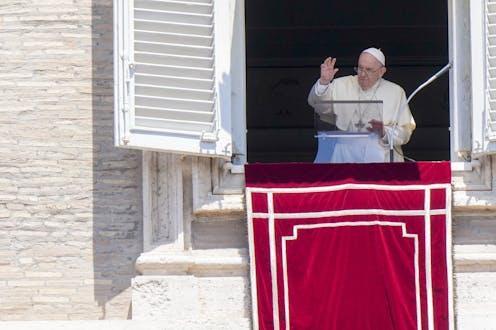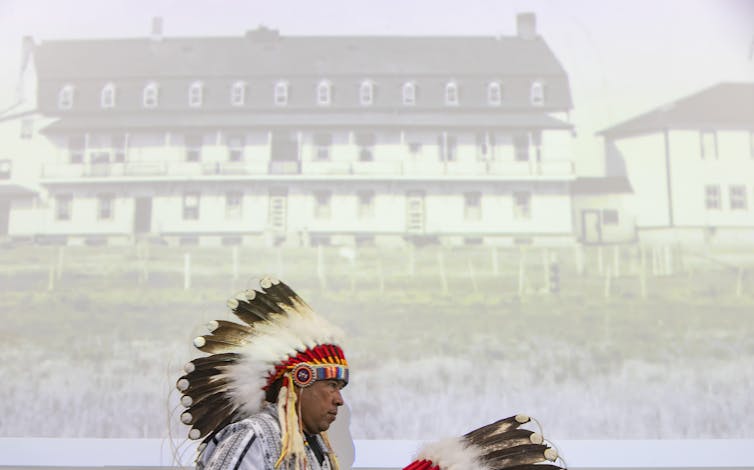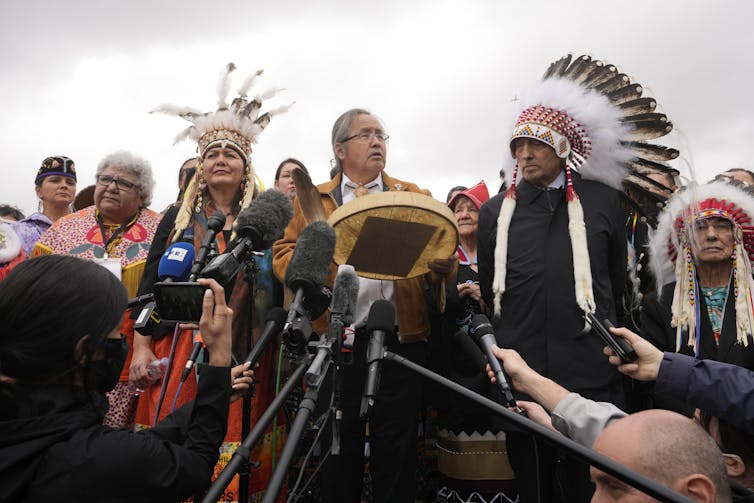
For whom did Pope Francis really organize his July 24-29 trip to Canada?
In general, these papal visits primarily concern Catholics and may not hold much interest for the general population. With stops in Sainte-Anne-de-Beaupré, Que., Edmonton, Maskwacis, Alta., and Iqaluit, this tour appears to be aimed primarily at Indigenous peoples: its purpose is to apologize on behalf of the Catholic Church for its involvement in Indian Residential Schools.
Indeed, of the 139 residential schools recognized by the legal definition of the Indian Residential Schools Settlement Agreement (IRSSA), approximately 60 per cent were run by Catholics. It makes sense, then, for Indigenous communities to be the primary audience for this visit.
Should the rest of Canada overlook the visit? On the contrary, I believe the whole country should be concerned by what’s at stake. I have every reason to to feel concerned: I am an anthropologist and have been doing research for over 25 years on colonization and its impacts, the Algonquin religious landscape and residential schools. But the issue at stake here goes far beyond the boundaries of academic research.

Rewriting, erasing or judging history
What is the issue, exactly?
It is about our relationship to history, specifically that of the construction of a state that marginalized Indigenous Peoples and tried to assimilate them in order to destroy their societies and cultures.
The Catholic Church played an important role in this construction, beginning in New France. Religious men and women founded the educational and hospital systems. The parishes structured the urban network. The missionaries worked, here and there, to extend the railroads and colonize the land.
They influenced policies, promoted agriculture and gave their names to many geographical features in cities, provinces and territories. In addition, with the ideas of their times, they wrote and disseminated opinions widely shared by their fellow citizens, but which today would be considered unacceptable.
Today, some are tempted to dismiss history as, “in the past,” or to rewrite history, erase it or refuse to inherit it.
Many elements of Canada’s Christian past no longer exist. We are shocked by the prejudice and racism that inflicted so much suffering on Indigenous people. Yet they continue to suffer from intergenerational trauma. In this sense, history lives on.
Many no longer want to pay tribute to figures — with statues, streets and schools — who have had devastating effects on Indigenous cultures and identity. Whether we judge them is another thing. How would we ourselves have acted in their place at the time? For that matter, how will we be judged by the generations that follow us?
Facing the past honestly
History is not black and white: it is complex, full of shades of grey, errors and compromises. Some religious people cared for and trained populations, they protected the French language. Some took up the cause of those whom they considered as their Indigenous brothers and sisters. Others, on the contrary, violated them, belittled them and prevented them from practising their own beliefs.
We cannot undo history. The French historian Pierre Nora wrote in 2006 about the French government’s memorial laws on genocide and colonization, arguing that it was dangerous to criminalize the past and allow what he called a “memorial hegemony” to emerge: in his view, it was important to define a collective and national history, rather than to allow a memory that was “essentially accusatory and destructive of that history.”
This does not mean denying some facts in favour of others. It means confronting all aspects of this history honestly. Our challenge now is to include Indigenous perspectives in a collective history, or rather to create a collective history using those of our three solitudes: English, French and Indigenous. After that, we will need to pass it on.

The dark role of the federal government
Our third temptation is to place all the blame for the history of residential schools on the missionaries.
Of course, they were largely responsible for it, through their dioceses and congregations. Their level of responsibility is high. But let’s not forget that it was the federal government that created the system and maintained it, and that it was Indian Affairs officers who identified the children and sent them to the residential schools.
This same government, under pressure from its superintendent of Indian Affairs, Duncan Campbell Scott, shelved the 1907 report by Dr. Peter Bryce. The latter urged the authorities to put in place measures that would limit mortality in Indian Residential Schools, mainly due to epidemics.
Dr. Bryce had noticed that at the File Hills Colony Residential School, in Saskatchewan (operated by the Presbyterians, and later by the United Church of Canada), nearly 70 per cent of the children died because of poor sanitary conditions. When he advocated measures as simple as separating the sick from the healthy children, he was not heard.

The general indifference of the population
Nor was public opinion moved by the existence of Indian Residential Schools or that they were intended to “civilize” Indigenous children. In April 1957, the newspaper Le Progrès wrote about the Amos Indian Residential School:
Their education as well as the food and clothing they receive are generous gifts from a government that is keen to help them adapt to a normal life in a civilized country, striving to build a courageous and proud people to defend their essential rights.
The mental and cultural well-being of these children was not taken into consideration, neither in the residential schools nor elsewhere. How many Indigenous children have disappeared from the child welfare system since the 1960s, during the the Sixties Scoop, and how many into the health-care system?
It took the work of researchers, journalists and government commissions to give families the tools they needed to begin searching for their loved ones.
We also inherit what troubles us
Our home and native land! True patriot love in all of us command. With glowing hearts we see thee rise, The True North strong and free! From far and wide, O Canada, we stand on guard for thee.
“With glowing hearts,” is everywhere in Canada’s history. As Canadians, we live with the benefits that history has bequeathed to us: a country that is democratic, free and safe, where we have universal health care, and so on.
But we cannot inherit only what is convenient for us. We also inherit a country where Indigenous people are less safe than others, where they have been deprived of freedoms and rights to participate in democratic life (they only obtained the right to vote in federal elections in 1960), where they can be unsafe in the health-care system.
The Pope’s solemn recognition, on Canadian soil, of the harm collectively suffered by Indigenous Peoples is part of a process of reconciliation and reparation that has only just begun, to bring a true closure to the past. We must therefore take this opportunity to accept difficult truths about our collective history and, in so doing, move forward in building a shared future.
Marie-Pierre Bousquet has received funding from SSHRC, FRQSC, Université de Montréal, Digital Museums Canada.
This article was originally published on The Conversation. Read the original article.







